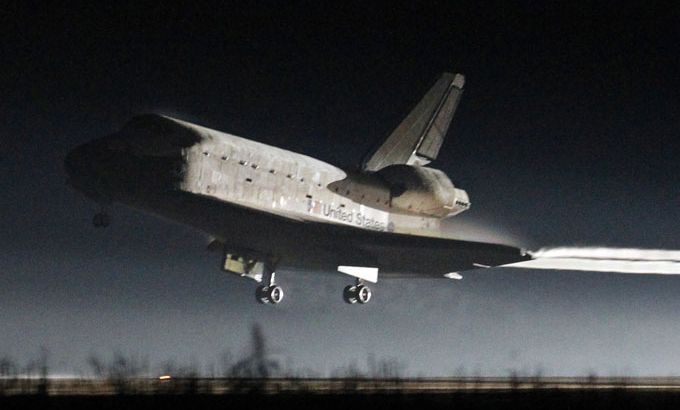Atlantis touches down for last landing
Four astronauts on final NASA space shuttle mission end voyage successfully at Kennedy Space Center.

Commander Chris Ferguson gently steered the 100-tonne spaceship high overhead, then nose-dived toward the swamp-surrounded landing strip at the Kennedy Space Center, a few kilometres from where Atlantis will go on display as a museum piece.
Double sonic booms shattered the predawn silence around the space center, the last time residents will hear the sound of a shuttle coming home.
The weather forecast was “very favourable” at Kennedy Space Center, NASA said, before the shuttle landed from a moonlit sky at 5:57am local time (0957 GMT).
“Mission complete, Houston,” Ferguson radioed to Mission Control.
Astronaut Barry Wilmore from Mission Control answered back, “We’ll take this opportunity to congratulate you Atlantis, as well as the thousands of passionate individuals across this great space-faring nation who truly empowered this incredible spacecraft, which for three decades has inspired millions around the globe”.
Atlantis, which has traveled over 8.4 million kilometres in its life-span, began its deorbit burn – during which engines fired for just over three minutes in order to slow the shuttle down – at 4:49 am (0849 GMT) to re-enter the Earth’s atmosphere.
The four-astronaut crew, who spent 13 days in space, were awoken at 9:29 pm on Wednesday (0129 GMT Thursday) to the sound of “God Bless America”, having left the International Space Station earlier in the day.
“This time I think a lot of people who were watching were feeling the significance, as the last event in the programme,” Morris Jones, a space analyst, said. “Over the next few years at least, things just won’t be the same for NASA.”
On Wednesday, pilot Doug Hurley said they were anxious to celebrate the landing with the shuttle’s on-the-ground crew.
“We’re very excited about seeing those folks … to share the memories of the mission with them and once again just convey how proud we are of them and what they’ve done over this 30-year programme,” he said.
End of an era
Atlantis’ landing ends an era of US dominance in human space exploration, leaving Russia as the sole taxi to the International Space Station until a replacement US capsule can be built by private industry.
Thursday’s landing also comes 42 years after US astronaut Neil Armstrong became the first person to step foot on the moon in the Apollo 11 mission.
“Forty-two years ago today, Neil Armstrong walked on the moon and I consider myself fortunate that I was there to actually remember the event,” Chris Ferguson, the Atlantis commander, said to mission control, recalling the images of July 20, 1969.
 |
| In Pictures: The space shuttle era |
“It is kind of interesting to be here on the final night of the shuttle mission. We don’t quite know what to think. We are just trying to take it all in.”
Over the course of the programme, five NASA space shuttles – Atlantis, Challenger, Columbia, Discovery and Endeavour – have comprised a fleet designed as the world’s first reusable space vehicles.
The first shuttle flight to space lifted off April 12, 1981.
Challenger and Columbia were destroyed in accidents that killed their crews – a total of 14 astronauts – leaving only three in the space-flying fleet and Enterprise, a prototype that never flew in space.
The remaining quartet will become museum pieces in the coming months.
Critics have assailed the US space agency for lacking a focus with the space shuttle gone and no next-generation human spaceflight programme to replace it.
The astronaut corps now numbers 60, compared to the 128 employed in 2000, and thousands of people are being laid off from Kennedy Space Center.
But NASA chiefs say future missions to deep space should revive hope in the US programme.
Details of future programmes are still pending but the overall objective is to build new spaceships that can travel beyond the International Space Station’s 400km orbit and send astronauts to the moon, asteroids and other destinations in deep space.
“We have just not done a good job of telling our story. NASA is very busy,” Charles Bolden, the space agency’s administrator, said. “The president said to us, 2025 for an asteroid and 2030 to Mars. We have a lot of work to do ahead.”